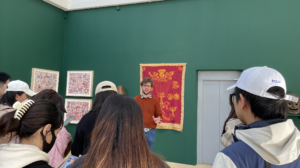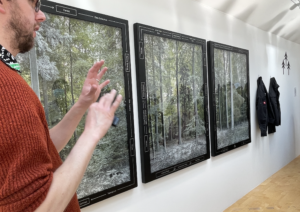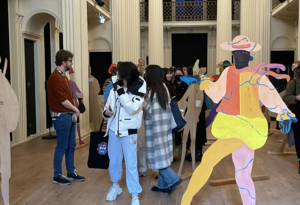This week James Clegg takes us back to Talbot Rice Gallery. Unlike the third week, which introduced the form and realisation of curating, this exhibition, The Accursed Share, is themed around subject matter and content. The main theme of the exhibition is the key word ‘debt’, which leads to a history of the shocking violence behind debt, and an anti-colonial perspective on Western empire building, colonisation, expulsion, subjugation, resource exploitation and militarisation. In the context of the current era of rising debt and cost of living crisis, the works on display at The Accursed Share explore how capitalism has changed our relationship with people and nature, leading us to consider the value of moving away from an all-too-common yet irrational form of violence that has become the norm.

I was impressed by this exhibition and it has been projected into my curatorial process. My curatorial concept has evolved from the initial beginnings of some ideas last year, to now starting to work on it and slowly completing it, but obviously it is still very shallow. I have thought about my conceptual development very much in terms of four core aspects of curation: theme, form, content and audience, and through these interrelated aspects I have explored different research-gathering strategies, drawing on methods from design thinking, anthropology and art. In terms of research methodology, I opted for a combination of online and offline approaches (as I have been working in UX design for a long time, I would be used to starting my research from the direction of user research, and in the field of curating, is it possible to think of ‘audience’ as ‘user’? (can “audience” be considered as “user” in the curating field?) I have been learning to observe through fieldwork and interviews; and experimenting with creative exercises.


The main thread of my work unfolds from the female perspective of ‘Pain’, using Pain as an entry point for the four artists to draw out the different perspectives that women display as a result of the hidden suffering in the social context, and the spiritual states and realms they enter as a result of this suffering in contemporary art practice. These works explore the marginal relationships of women who are implicitly disciplined and restrained by society, and the projection of female self-consciousness in these ‘sufferings’, leading the viewer to consider the stereotypes and hidden atrocities that we have taken for granted about the ‘second sex’.
So in my curatorial text, I ask: how can the connection between female suffering and spirituality be considered? The portrayal of female suffering from a male perspective seems to have emerged as a grotesque obsession throughout art history, yet it is so widespread, so easily ignored and hollowed out. This lack of subjectivity requires women to interpret the memory of pain and the understanding of feminine wisdom from a different perspective. It is not that pain makes women conform to a certain aesthetic appeal, but that women are artistic because they are caught in the realm of pain and enter the spiritual world of reflection. Four East Asian artists give their answers and perspectives on this understanding.
Deng Xiaoshuo is a young female artist working in public art at Musashino Art University in Japan. She focuses on the ordinary things around her, returning to issues such as personal history, women’s living space and emotional dialogue between women in the context of capitalist society. Her work has been shown in many exhibitions and she is a new talent on the contemporary art scene in the Chinese-speaking world. I discovered her work at the Musashino Art University Art Festival and it had so much potential that I chose her as a major part of my curatorial work. For example, I was struck by her Fireworks, in which a pair of high heels full of women’s blood and tears appear like blooming sparks in a group painting; Temperature retrieves the sense of connection between the individual woman and consumer society and history by tracing her mother’s clothing over a period of thirty years;;
Luo Xinyue is a student artist at MA CAP, Edinburgh College of Art, and she thinks primarily in terms of ‘fulfilling the responsibilities and duties assigned to her by secular society’. Feminism is the inspiration for her work, which combines performance and painting to explore how to balance the contradictions of a future identity, free from the constraints of the present and existing in the world with a broader cosmic view. Her work Chaos and the series that followed began with her trauma-filled personal experiences, exploring biological and secular psychology of gender differences, and in the work Vanish explores ancient mythological imagery. As for Chen Mu, she is a young artist studying traditional Chinese painting, and her works are mostly self-portraits or untitled portraits that aim to explore a new state of being for women under the traditional aesthetic gaze. Lastly, there is the video work The Daughter of Confucius and Mencius by the artist Li Xinhao, who, as a male filmmaker, excavates an alternative oppression and evil from contemporary life through the Confucian ideology that has ruled China for two millennia, a very controversial thing in itself, as I commented on him in my previous blog.
In talking about the process of forming this art project of my own, I started by identifying key words and derivative concepts, and with this concept searched around for artists who fit my expectations, so I think my main line is still relatively clear. The research method I used was also very simple, in my previous communication with my tutor Jake I opened up some of my thoughts on that content through the work of some contemporary art masters, drawing inspiration I started to write down some basic ideas in sketch to form it into a kind of knowledge network. Then I sought out the artists and I interviewed them, writing them down like the blog for week 8. Their experiences, their personal feelings, are important material for me to curate and a window to understand their work. For my project, I wanted it to be more than just my first curatorial project, I wanted it to be a way of changing people’s perceptions. In general, my project is not radical, nor am I a radical feminist, but I hope that by presenting the artists’ understanding of ‘women’s pain’, I can awaken a sense of empathy and understanding, and in our own life, overcome a stereotypical mindset rather than continue to ‘victimize’ the women around us.


Leave a Reply